THE WORLD BIRDS - An Online Bird Book
RAPTORS - Kites
RAPTORS - Kites
Raptors are birds of prey. They are carnivorous, long lived, and have low reproductive rates. They catch their prey via strong claws – three pointing forward and one pointing backward. The raptors that hunt by day are: hawks, eagle, kites, vultures, falcons. Owls hunt by night. The raptors are spread over a number of orders: Accipitriformes (hawks and allies), Cathartiformes (New World vultures), Falconiformes (falcons), Strigiformes (owls).
Unlike most other birds, or mammals for that matter, almost all female raptors are larger than their male counterpart. There is no consensus as why evolution worked this way for the raptor. The theory I like best is that the bigger female can defend the nest better, while the smaller male is more agile and can find lots of little prey to bring home to the nest. That is, when the chicks are young, they need lots of little tidbits, not one humungous carcass. A side benefit of having male and female being different in size is that they tend to go after different food sources so that way they are not competing with each other for food. But if males were the bigger ones, that diversity benefit would also be true. So perhaps the overarching reason, is the male bringing home lots of tidbits.
Raptors, especially those that stalk prey from the air, tend to have dark upperparts and lighter underparts. Looking down from above a raptor, the dark upperparts tend to blend in with the ground. While looking from below, the light underparts blend better with the sky.
Many of the raptors have their conservation status listed as something other than Least Concern; that is, there is some concern about their survival. A contributing factor is that raptors need a considerable area to offer them sufficient prey. As habitats degrade, they have less area to patrol, and less prey in the remaining areas, a double whammy. Also, for millennia, raptors have been at the top of the food chain and did not need to worry about their longterm survival. As a result, they have evolved to have few offspring, sometimes only 1. Thus if a population decreases, it is hard for it to recover.
Accipitriformes
The order Accipitriformes is made of of three families: Accipitridae, Pandionidae, and Sagittariidae. Accipitridae contains the hawks, eagles, kites, Old World vultures. Pandionidae only contains one species - the osprey, and Sagittariidae only contains the secretary bird.
Accipitridae
Accipitrine raptors generally have broad wings with rounded ends. As indicated below, the family is divided into 9 subfamilies. The characteristics of each of the subfamilies will be given prior to a description for each of their species. A confusing factor for presenting the subfamilies is that common terms such as eagles or kites do not correspond to a specific subfamily. For example, eagles belong to two different subfamilies and kites to 5 subfamilies!
The Accipitridae family has the following subfamiles:
Aquilinae – booted eagles
Circaetinae – serpent eagles
Harpiinae – forest eagles
Accipitrinae – accipitrine hawks
Buteoninae – buteonine hawks
Harpaginae – harpagine hawks
Melieraxinae – melieraxine hawks
Elaninae – elanine kites
Perninae – honey-buzzards
Gypaetinae – gypaetine vultures and harrier-hawks
Gypinae – Old World vultures
Kites
Unlike most other birds, or mammals for that matter, almost all female raptors are larger than their male counterpart. There is no consensus as why evolution worked this way for the raptor. The theory I like best is that the bigger female can defend the nest better, while the smaller male is more agile and can find lots of little prey to bring home to the nest. That is, when the chicks are young, they need lots of little tidbits, not one humungous carcass. A side benefit of having male and female being different in size is that they tend to go after different food sources so that way they are not competing with each other for food. But if males were the bigger ones, that diversity benefit would also be true. So perhaps the overarching reason, is the male bringing home lots of tidbits.
Raptors, especially those that stalk prey from the air, tend to have dark upperparts and lighter underparts. Looking down from above a raptor, the dark upperparts tend to blend in with the ground. While looking from below, the light underparts blend better with the sky.
Many of the raptors have their conservation status listed as something other than Least Concern; that is, there is some concern about their survival. A contributing factor is that raptors need a considerable area to offer them sufficient prey. As habitats degrade, they have less area to patrol, and less prey in the remaining areas, a double whammy. Also, for millennia, raptors have been at the top of the food chain and did not need to worry about their longterm survival. As a result, they have evolved to have few offspring, sometimes only 1. Thus if a population decreases, it is hard for it to recover.
Accipitriformes
The order Accipitriformes is made of of three families: Accipitridae, Pandionidae, and Sagittariidae. Accipitridae contains the hawks, eagles, kites, Old World vultures. Pandionidae only contains one species - the osprey, and Sagittariidae only contains the secretary bird.
Accipitridae
Accipitrine raptors generally have broad wings with rounded ends. As indicated below, the family is divided into 9 subfamilies. The characteristics of each of the subfamilies will be given prior to a description for each of their species. A confusing factor for presenting the subfamilies is that common terms such as eagles or kites do not correspond to a specific subfamily. For example, eagles belong to two different subfamilies and kites to 5 subfamilies!
The Accipitridae family has the following subfamiles:
Aquilinae – booted eagles
Circaetinae – serpent eagles
Harpiinae – forest eagles
Accipitrinae – accipitrine hawks
Buteoninae – buteonine hawks
Harpaginae – harpagine hawks
Melieraxinae – melieraxine hawks
Elaninae – elanine kites
Perninae – honey-buzzards
Gypaetinae – gypaetine vultures and harrier-hawks
Gypinae – Old World vultures
The name "kite" when used to name a bird species generally implies that the species spends some time soaring like a kite. All the kites are raptors and belong to the family Accipitridae. They come from the following subfamiles: Buteoninae, Elaninae, Harpaginae, and Perninae. Kites aer also in tribe Milvini which such some consider to belong to subfamily Buteoninae of the buteonine hawks. Others consider elevating the tribe to a family called Milvinae.
Kites are spread over many subfamilies instead of one over-arching subfamily because, other than being able to soar, there is no agreed upon set of characteristic to describe the group. Rather, what is a called kite is often in eyes of the namer. But the lack of uniformity for "kites" is not unusual. An other example is the term "hawk". Hawks come from the subfamilies: Accipitrinae, Buteoninae, Harpaginae, and Melieraxinae.
The following table lists the various species that are called kites, givs their subfamily, and the continent(s) where it is found.
| Scientific Name | Common Name | Subfamily/Tribe | NA | SA | EU | AS | AF | AU |
| Chelictinia riocourii | Scissor-tailed kite | Elaninae | AF | |||||
| Chondrohierax uncinatus | Hook-billed Kite | Perninae | NA | SA | ||||
| Elanoides forficatus | Swallow-tailed Kite | Perninae | NA | SA | ||||
| Elanus axillaris | Australian Kite | Elaninae | AU | |||||
| Elanus caeruleus | Black-winged Kite | Elaninae | EU | AS | AF | |||
| Elanus leucurus | White-tailed Kite | Elaninae | NA | SA | ||||
| Elanus scriptus | Letter-winged Kite | Elaninae | AU | |||||
| Gampsonyx swainsonii | Pearl Kite | Elaninae | SA | |||||
| Haliastur indus | Brahminy Kite | Milvini | AS | AU | ||||
| Haliastur sphenurus | Whistling Kite | Milvini | AU | |||||
| Hamirostra melanosternon | Black-breasted Kite | Perninae | AU | |||||
| Harpagus bidentatus | Double-toothed Kite | Harpaginae | SA | |||||
| Harpagus diodon | Rufous-thighed Kite | Harpaginae | SA | |||||
| Helicolestes hamatus | Slender-billed Kite | Buteoninae | SA | |||||
| Ictinia mississippiensis | Mississippi Kite | Buteoninae | NA | SA | ||||
| Ictinia plumbea | Plumbeous Kite | Buteoninae | SA | |||||
| Leptodon cayanensis | Grey-headed Kite | Perninae | SA | |||||
| Leptodon forbesi | White-collared Kite | Perninae | SA | |||||
| Lophoictinia isura | Square-tailed Kite | Perninae | AU | |||||
| Milvus aegyptius | Yellow-billed Kite | Milvini | AF | |||||
| Milvus migrans | Black Kite | Milvini | EU | AS | AF | |||
| Rostrhamus sociabilis | Snail Kite | Buteoninae | NA | SA |
Elaninae – elanine kites
The kites of the Elaninae subfamily are sometimes refered to as the "white-tailed" kites. Most of them are graceful in flight and pleasing to look at. They nest in trees, laying 2 to 5 white eggs with dark mottling.
The subfamily contains 6 kite species and 4 of those are in genus Elanus. The Elanus kites are small raptors, all are less than 450 grams. They have mainly white and grey plumage and have black wing marking. They search for prey from a low and slow flight, or while hovering. These kites have large heads, a short neck, and a short and square tail. The scissor-tailed kite, Chelictinia riocourii, is a small grey and white kite that has a deeply forked tail and hunts mainly whiile soaring or hovering. The pearl kite, Gampsonyx swainsonii, is the smallest raptor in the Americas. It is mainly black and white and hunts from a perch.
Genus Chelictinia - 1 species
Kite,_Scissor-tailed Chelictinia riocourii
Description: The scissor-tailed kite, also known as the African swallow-tailed kite, has grey upperparts including the crown. It has white underparts, including the forehead, face, and throat. It has long pointed wings and a deeply forked tail. The under-wings are white except for a black patch on the coverts. The eyes are red. A small kite, it is 33 to 38 cm long.
Range: northern tropics of Africa.
Habitat: Acacia scrub when breeding, otherwise grassy areas. Roost coloniallys at night.
Diet: Mainly insect. Also lizards, rodents. Hunts mainly while soaring or hovering.
Conservation status: Least Concern.
Image by: 1) Dick Daniels - Tanzania 2) BioDiv Library 3) Nik_Borrow - Senegal 4) Ron_Knight - CameroonRange: northern tropics of Africa.
Habitat: Acacia scrub when breeding, otherwise grassy areas. Roost coloniallys at night.
Diet: Mainly insect. Also lizards, rodents. Hunts mainly while soaring or hovering.
Conservation status: Least Concern.
1) Juvenile


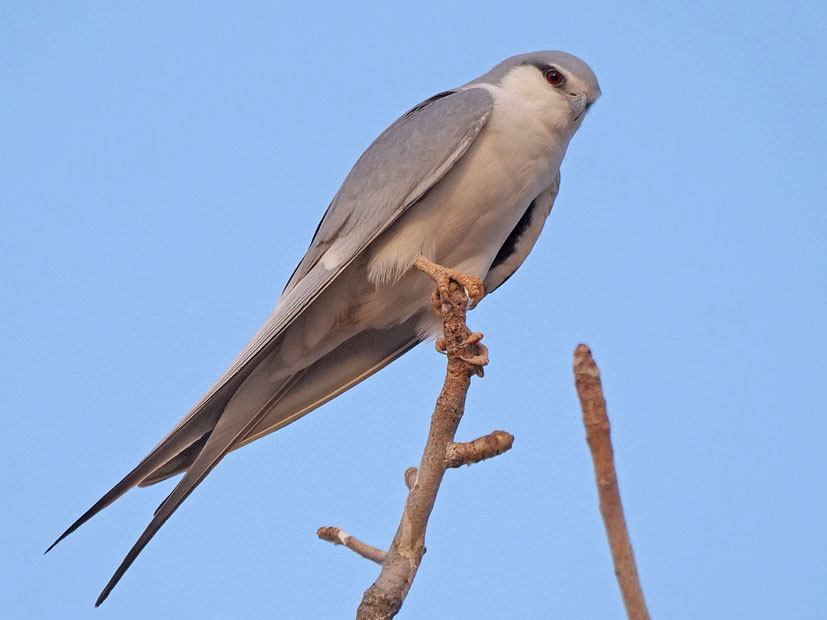
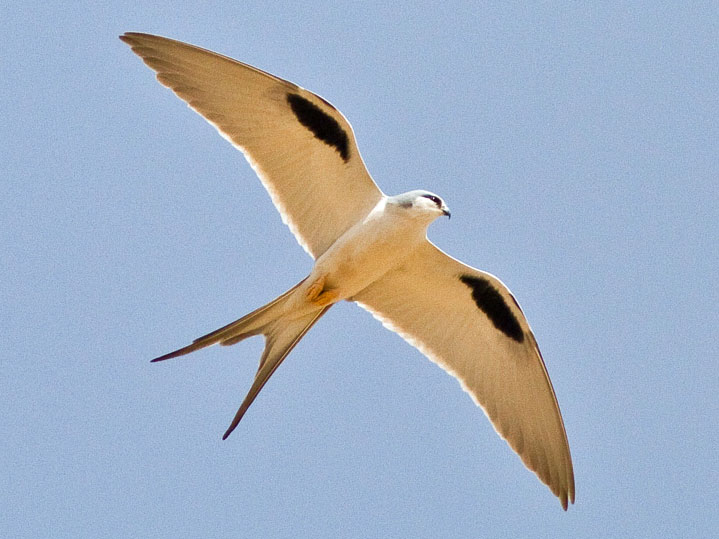
Genus Elanus
These are small raptors, all are less than 450 grams. They have mainly white and grey plumage and have black wing marking. They search for prey from a low and slow flight, or while hovering. These kites have large heads, a short neck, and a short and square tail.
Kite,_Black-winged Elanus caeruleus
Description: The black-winged kite, also known as the black-shouldered kite, has grey upperparts including the upper surfaces of the primaries. It has black shoulders, under surface of the primaries, and black around the eyes. The face is white as are the underparts. The head is large, the tail short. It is 30 - 37 cm long, male weighs up to 275 grams, female to 350 g. The Australian kite and black-winged kite were previously considered to be the same species. Their ranges do not overlap.
Range: Europe, Africa, southern Asia, Indonesia, Philippines, Papua New Guinea.
Habitat: Open land, semi-desert.
Diet: Grasshoppers and other large insects, lizards, rodents.
Conservation status: Least Concern.
Image by: 1) Thomas_Schoch - Namibia 2) Dick Daniels - Radical Raptors, South Africa 3) Dick - Nairobi National Park, Kenya 4) JM Garg - IndiaRange: Europe, Africa, southern Asia, Indonesia, Philippines, Papua New Guinea.
Habitat: Open land, semi-desert.
Diet: Grasshoppers and other large insects, lizards, rodents.
Conservation status: Least Concern.
1) Juvenile




|
Kite,_Australian Elanus axillaris
Description: The Australian kite, also known as the black-shouldered kite, has grey upperparts including the upper surfaces of the primaries. It has black shoulders, under surface of the primaries, and black around the eyes. The face is white as are the underparts. The head is large, the tail short. It is 33 - 37 cm long, male weighs up to 300 grams, female to 375 g. The Australian kite and black-winged kite were previously considered to be the same species. Their ranges do not overlap.
Range: Australia.
Habitat: Grassland and open woodlands.
Diet: Mainly rodents. Also grasshoppers and other large insects, lizards.
Conservation status: Least Concern.
Image by: 1) David
Cook - South Australia 2) Patrick_K59 - Australia Wayne Butterworth - Australia David Jenkins - AustraliaRange: Australia.
Habitat: Grassland and open woodlands.
Diet: Mainly rodents. Also grasshoppers and other large insects, lizards.
Conservation status: Least Concern.




Kite,_Letter-winged Elanus scriptus
Description: The Letter-winged Kite has mainly white plumage with a bold black stripe on the shoulders and wings. The black wing resembles a W or an M depending on one's point of view, thus this species name. It is up to 37 cm in length and weighs up to 425 grams.
Range: Australia.
Habitat: Timbered grasslands. Roosts in trees.
Diet: Mainly rodents. Forages similar to terns - slow flight and then hovering.
Conservation status: The letter-winged kite is listed as Near Threatened because its population is small when rat population is low. A small population is then vulnerable to habitat changes.
Image by: 1) Frank_Pierce 2, 3) Nik_Borrow 4) Ron Knight - Australia Range: Australia.
Habitat: Timbered grasslands. Roosts in trees.
Diet: Mainly rodents. Forages similar to terns - slow flight and then hovering.
Conservation status: The letter-winged kite is listed as Near Threatened because its population is small when rat population is low. A small population is then vulnerable to habitat changes.

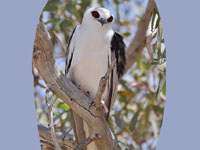
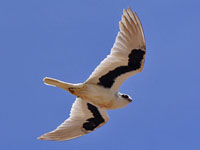

Kite,_White-tailed Elanus leucurus
Description: The white-tailed kite has grey upperparts, black shoulders, a white face, and white underparts. There is a black patch around the eyes. The white tail is short and the head is large. The white-tailed Kite has whiter head and blacker shoulders than the similar Mississippi kite. it is a medium sized kite, 35 - 43 cm in length and weighs between 250 and 380 grams.
Range: Central and South America. Also the West Coast of North America.
Habitat: Graasy areas. Nests and roosts in trees.
Diet: Mammals. Usually hunts by hovering.
Conservation status: Least Concern.
Image by: 1, 2) Maggie Smith - California 3) Gerardo Santos - Mexico 4) Tom Clifton - California Range: Central and South America. Also the West Coast of North America.
Habitat: Graasy areas. Nests and roosts in trees.
Diet: Mammals. Usually hunts by hovering.
Conservation status: Least Concern.
1) Juvenile


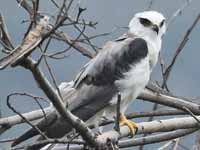

Genus Gampsonyx - 1 species
Kite,_Pearl Gampsonyx swainsonii
Description: The pearl kite has black upperparts, wings, and tail. It has a buffy forehead and a dark partial collar. The underparts are white and the legs are yellow. At less than 24 cm in length and less than 100 grams in weight, it is the smallest raptor in the Americas.
Range: Central and South America.
Habitat: Grassy areas, open tropical woodlands.
Diet: Mainly lizards. Usually hunts from a perch, but lso hunts from slow flight.
Conservation status: Least Concern.
Image by: 1) Barloventomagico - Venezuela 2) Dave_Curtis - Guyana 3) Tony_Castro - Ecuador Range: Central and South America.
Habitat: Grassy areas, open tropical woodlands.
Diet: Mainly lizards. Usually hunts from a perch, but lso hunts from slow flight.
Conservation status: Least Concern.

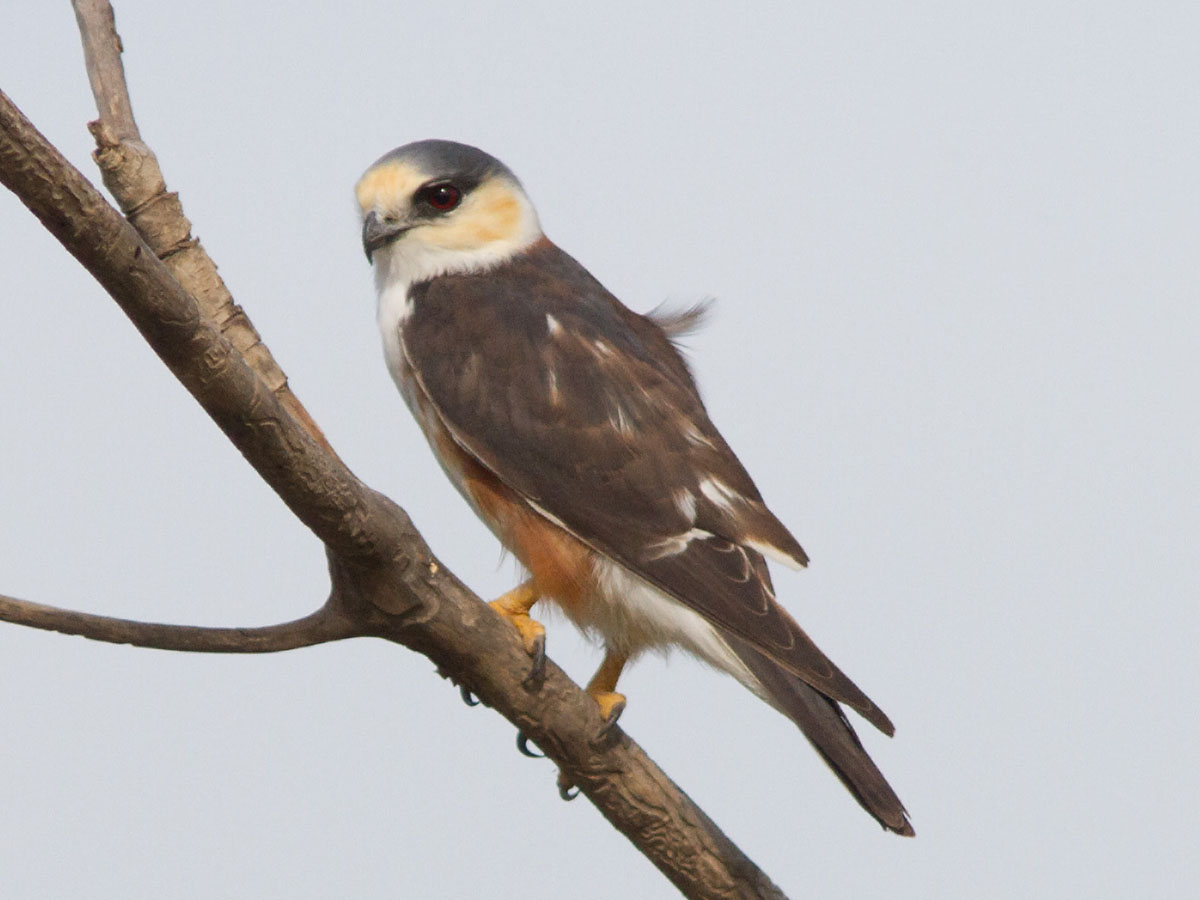

Perninae: Bazas, Honey-buzzards, and Kites
Genus Aviceda
The bazas, also known as cuckoo-hawks, all have a crest on the head. They are distributed from Australia to southern Asia and across to Africa.
Baza,_African Aviceda cuculoides
Description: The male African Baza, also knows as the African cuckoo-hawk, has blackish-brown upperparts with a grey mantle and breast. It has a blackish crest. The underparts are white marked with broad chestnut bars. The tail is black with three grey bars and grey and white tip. The females are browner with paler chestnut bars on the underparts. It has a 38 - 43 cm length and weighs up to 300 grams.
Range: southern Africa.
Habitat: Dense woodland and forest of either indigenous or exotic trees.
Diet: Lizards, large insects, crabs, fish.
Conservation status: Least Concern.
Image by: 1, 2) Steve_Garvie 3) Peter_Steward - Malawi 4) Dave_Curtis - GhanaRange: southern Africa.
Habitat: Dense woodland and forest of either indigenous or exotic trees.
Diet: Lizards, large insects, crabs, fish.
Conservation status: Least Concern.




Baza, Black Aviceda leuphotes
Description: The Black Baza has a black crest, head, and neck. The upperparts are mainly black with some white. It has a white upper-breast, and whitish lower-breast plus upper-belly with black bars. The lower-belly and vent are black. It has black under-wing coverts and black primary tips with the rest of under-wing white.
Range: Asia, Indonesia.
Habitat: Open forests. Also other open areas with trees nearby.
Diet: Mainly large insects. Also lizards, tree frogs.
Conservation status: Least Concern.
Image by: 1) Johnny Wee 2, 3) Vijay Ismavel - Assam, India 4) DChai21 - SingaporeRange: Asia, Indonesia.
Habitat: Open forests. Also other open areas with trees nearby.
Diet: Mainly large insects. Also lizards, tree frogs.
Conservation status: Least Concern.

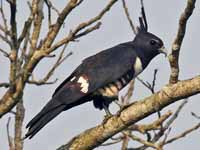


Baza, Jerdon's Aviceda jerdoni
Description: The Jerdon's baza has greyish-brown upperparts and a prominent white-tipped black crest. The head and nape are brown. It has rufous barred underparts and three black tail bands with a whitish tip. It is 41 to 48 cm long and averages 353 grams in weight.
Range: southeast Asia, Indonesia, Malaysia, Philippines.
Habitat: Forest, forest edges, and clearings.
Diet: Lizards, grasshoppers and other large insects. Hunts from a perch in a tree.
Conservation status: Least Concern.
Image by: 1, 2) Bernard Dupont - Malaysia 3) Saud Faisal Range: southeast Asia, Indonesia, Malaysia, Philippines.
Habitat: Forest, forest edges, and clearings.
Diet: Lizards, grasshoppers and other large insects. Hunts from a perch in a tree.
Conservation status: Least Concern.
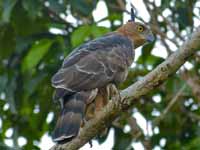


Baza, Pacific Aviceda subcristata
Description: The Pacific Baza has brown tinged slate-grey upperparts, a grey head with a short crest, grey upper-breast, and a whitish lower breast and belly with dark bars. It is 35 to 46 cm in length and weighs 260 to 450 grams.
Range: Australasia.
Habitat: Forests, savanna, water bodies.
Diet: Fruits, insects, tree-frogs, lizards, snakes, and birds.
Conservation status: Least Concern.
Image by: 1) Aviceda - SE Queensland, Austalia 2) Stephan Barnett 3) Adrian Wiggins 4) Lip
Kee Yap - Wulagi, Darwin, NT, AURange: Australasia.
Habitat: Forests, savanna, water bodies.
Diet: Fruits, insects, tree-frogs, lizards, snakes, and birds.
Conservation status: Least Concern.
3) Stuffed




Cuckoo-Hawk, Madagascar Aviceda madagascariensis
Description: The Madagascar cuckoo-hawk, also known as the Madagascar baza, has dark brown upperparts with a paler head. The underparts are white and mostly streaked with brown. The streaks on the flanks are finer. The tail is barred with a pale tip. The flight feathers have broad dark bars on their undersides. The cere and legs are whitish or grey. It is 40 - 45 cm long.
Range: Madagascar.
Habitat: Forests, especially forest clearings. Also countryside around forests.
Diet: Mainly small reptiles and large insects.
Conservation status: Least Concern.
Image by: 1) John Gerrard Keulemans Range: Madagascar.
Habitat: Forests, especially forest clearings. Also countryside around forests.
Diet: Mainly small reptiles and large insects.
Conservation status: Least Concern.
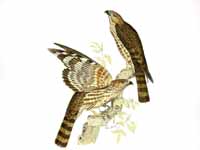
Genus Chondrohierax - 1 species
Kite,_Hook-billed Chondrohierax uncinatus
Description: The male hook-billed kite usually has bluish-grey upperparts and grey underparts with white or buff bars. The female usually has brown upperparts and rusty breast with fine white bars. The bill of the hook-billed kite has adapted in size and shape between different regions of their territory in response to the species of tree snail available to them. It is 38 to 51 cm longs and weighs between 215 and 400 grams. The snail kite has a similar bill, but their plumage is not similar.
Range: South central USA to South America, Caribbean.
Habitat: Rain forest, mesquite woodland, and various other areas where snails are plentiful. Nests in trees.
Diet: Mainly snails. Also frogs, reptiles, insects.
Conservation status: Least Concern.
Image by: 1) Cláudio Dias Timm - Brazil 2) Alejandro_Bayer_Tamayo - Columbia 3) Nick Athanas - Ecuador 4) David Cook - Peru Range: South central USA to South America, Caribbean.
Habitat: Rain forest, mesquite woodland, and various other areas where snails are plentiful. Nests in trees.
Diet: Mainly snails. Also frogs, reptiles, insects.
Conservation status: Least Concern.
1, 2) Female 3, 4) Male




Genus Elanoides - 1 species
Kite,_Swallow-tailed Elanoides forficatus
Description: The swallow-tailed kite has blackish upperparts, white underparts, and a long forked black tail. It is a graceful flyer and seems to soar or glide effortlessly. It has a black bill and black feet, is 50 to 68 cm in length, and weighs 310 to 600 grams.
Range: Southeast USA to South America.
Habitat: Wetland forests. Favorite nesting trees are tall loblolly pines and bald cypress. In winter it migrates to South America.
Diet: Lizards, small mammals, insects, amphibians. This prey is often captured in high tree tops.
Conservation status: Least Concern.
Image by: 1) Joe Nicholson -
Florida 2) Lauren Anderson - Avian Reconditioning Center, Florida 3) Amy Evenstad 4) Dick Daniels - Ash, North Carolina Range: Southeast USA to South America.
Habitat: Wetland forests. Favorite nesting trees are tall loblolly pines and bald cypress. In winter it migrates to South America.
Diet: Lizards, small mammals, insects, amphibians. This prey is often captured in high tree tops.
Conservation status: Least Concern.


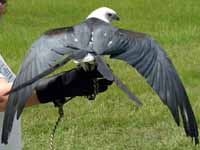

Genus Eutriorchis - 1 species
All of the other species that are known a serpent-eagles or snake-eagles are placed in the eagle subfamily Circaetinae. The Madagascar serpent-eagle is placed here in Perninae subfamily of honey-buzzards.
For other serpent-eagles, see Spilornis and Dryotriorchis.
Eagle,_Madagascar Serpent- Eutriorchis astur
Description: The Madagascar serpent-eagle has dark grey upperparts. The underparts are lighter grey with dark barring. It has yellow eyes and legs. The tail is long, rounded and barred. The Madagascar serpent-eagle is 57 to 66 cm long.
Range: Madagascar.
Habitat: Dense, humid, and broadleafed evergreen forests. It is usually found below 500 m.
Diet: Reptiles, lemurs, frogs.
Conservation status: Madagascar serpent-eagle is listed as Endangered. The very small population is still probably declining due to habitat loss.
Image by: John Gerrard KeulemansRange: Madagascar.
Habitat: Dense, humid, and broadleafed evergreen forests. It is usually found below 500 m.
Diet: Reptiles, lemurs, frogs.
Conservation status: Madagascar serpent-eagle is listed as Endangered. The very small population is still probably declining due to habitat loss.

Genus Hamirostra - 1 species
Kite,_Black-breasted Hamirostra melanosternon
Description: The black-breasted kite, also known as the black-breasted buzzard, is one of Australia's largest raptors. It has mainly dark plumage. The nape is rufous and the shoulders have rufous mottling. The under-wings have a white panel near their wingtips. It is 51 to 61 inches long. Males average 1200 grams and females 1330.
Range: Australia.
Habitat: Mainly forests near water. Also found in open habitats.
Diet: Reptiles, mammals, birds, and bird eggs.
Conservation status: Least Concern.
Image by: 1, 2) Benjamint444b -
Annapurna region of Nepal 3) Lip Kee - Northern TerritoryRange: Australia.
Habitat: Mainly forests near water. Also found in open habitats.
Diet: Reptiles, mammals, birds, and bird eggs.
Conservation status: Least Concern.



Genus Leptodon
These two spcies have a grey head, black upperparts and white underparts.
Kite,_Gray-headed Leptodon cayanensis
Description: The grey-headed kite has black upperparts, grey head, white underparts, black tail with 2 or 3 white bars, blue bill; and grey legs. It is 46–53 cm in length and weighs 410-605 grams.
Range: Mexico, Central America, South America.
Habitat: Rainforest, usually near waterbodies.
Diet: Mainly reptiles; also frogs, large insects. It sits on a high perch seeking prey.
Conservation status: Least Concern.
Image by: 1) Victor Burolla - Costa Rica 2) Claudi Timm 3) Jerry OIdenettel - VenezuelaRange: Mexico, Central America, South America.
Habitat: Rainforest, usually near waterbodies.
Diet: Mainly reptiles; also frogs, large insects. It sits on a high perch seeking prey.
Conservation status: Least Concern.



Kite,_White-collared Leptodon forbesi
Description: The white-collared kite has black upperparts, and grey head. It has white hind-neck and underparts. The grey tail has broad a subterminal band and a narrow whitish tip. It is is 49–50 cm long and weighs 550–580 grams.
Range: Northeast Brazil.
Habitat: Coastal rainforest.
Diet: Unknown.
Conservation status: The white-collared kite is listed as Critically Endangered as there have been very few recent sightings. Its habit has had massive destruction.
Image by: 1) Yuri_RaiaRange: Northeast Brazil.
Habitat: Coastal rainforest.
Diet: Unknown.
Conservation status: The white-collared kite is listed as Critically Endangered as there have been very few recent sightings. Its habit has had massive destruction.

Genus Lophoictinia - 1 species
Kite,_Square-tailed Lophoictinia isura
Description: The square-tailed kite has a whitish face, streaked breast, and a barred square tail with dark sub-terminal band. It is 50 - 56 cm long and weighs 550 to 580 grams.
Range: Australia.
Habitat: Open forests, scrub, savannah.
Diet: Birds, mice, insects, snail, snakes. Hunts while soaring or closer to ground.
Conservation status: Least Concern.
Image by: 1) Patrick_K59 2) Graham_Winterflood 3, 4) Laurie_Boyle Range: Australia.
Habitat: Open forests, scrub, savannah.
Diet: Birds, mice, insects, snail, snakes. Hunts while soaring or closer to ground.
Conservation status: Least Concern.


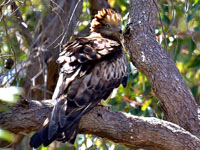

Genus Pernis
The Honey-Buzzards breed in temperate regions of the Old World. They feed on bee / wasp larvae, as well as the bees themselves and their honey.
Buzzard,_Barred_Honey- Pernis celebensis
Description: The barred honey-buzzard, also known as the Sulawesi honey-buzzard, has brown upperparts, dark crown, buffy breast with brown streaks, and barred belly. It is 50 - 58 cm long.
Range: Sulawesi of Indonesia.
Habitat: Forests, forest edges and clearings.
Diet: Bees, their larvae, honeycombs.
Conservation status: Least Concern.
Image by: 1) Francesco_VeronesiRange: Sulawesi of Indonesia.
Habitat: Forests, forest edges and clearings.
Diet: Bees, their larvae, honeycombs.
Conservation status: Least Concern.

Buzzard,_European Honey- Pernis apivorus
Description: The European honey-buzzard, also known as the honey-buzzard, has a small blue-grey (male) or brown (female) head. It has yellow-orange eyes. There are many morphs, but generally the upperparts are grey-brown. the underparts heavily barred, and the throat is streaked. The tail has two dark central bands and one dark terminal band. It is 52 to 60 cm long, male less than 950 grams, and female less than 1050 g. The juvenile has brown eyes. The similar common buzzard has a larger head and the European honey-buzzard has fewer bars on its tail.
Range: Europe, Asia, Africa.
Habitat: Perfers woodlands. Migrates to Africa for the winter.
Diet: Mainly bees/ wasps and their larvae. It tears off the stinger and venom before swollowing the insect. Also mammals, reptiles, birds.
Conservation status: Least Concern.
Image by: 1) Bernard_Dupont 2) Jo
Mur - Zambia 3) Jan_Svetlik 4 ) Cristiano Crolle - Italy Range: Europe, Asia, Africa.
Habitat: Perfers woodlands. Migrates to Africa for the winter.
Diet: Mainly bees/ wasps and their larvae. It tears off the stinger and venom before swollowing the insect. Also mammals, reptiles, birds.
Conservation status: Least Concern.

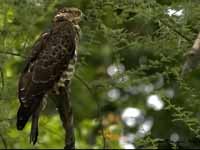

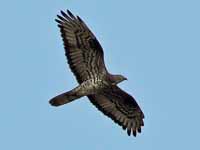
Buzzard,_Oriental Honey- Pernis ptilorhynchus
Description: The Oriental honey-buzzard, also known as the crested honey-buzzard, has a long neck and small blue-grey (male) or brown (female) head. The upperparts are dark brown, the underparts are lighter brown, and there is a dark throat stripe. The head is pigeon-like in appearance. It is 62 to 68 cm in length, male weighs up to 1300 grams, and female to 1500 grams which makes it larger than the European honey-buzzard.
Range: Asia, Indonesia, Philippines.
Habitat: Varied including dense forest and open spaces.
Diet: Mainly bees/wasps, their larvae honey, and honeycomb.
Conservation status: Least Concern.
Image by: 1) J M Garg 2) Koshy Koshy - India 3) Hiyashi Haka - Taiwan 4) Umang Dutt - India 5) Sergey Yeliseev - India Range: Asia, Indonesia, Philippines.
Habitat: Varied including dense forest and open spaces.
Diet: Mainly bees/wasps, their larvae honey, and honeycomb.
Conservation status: Least Concern.





